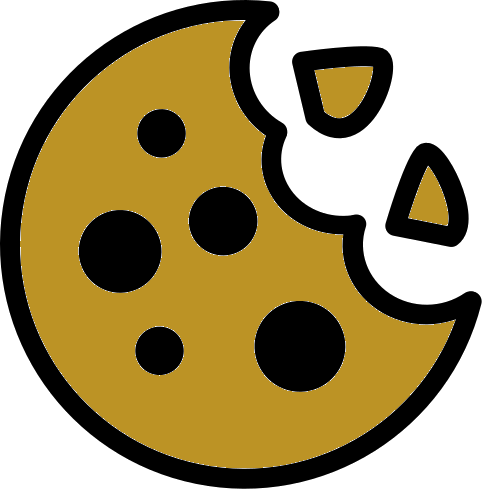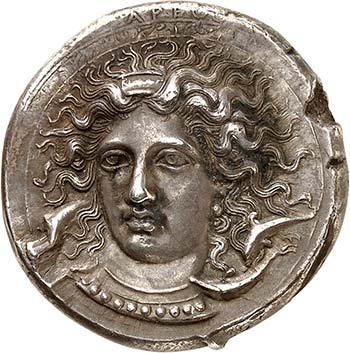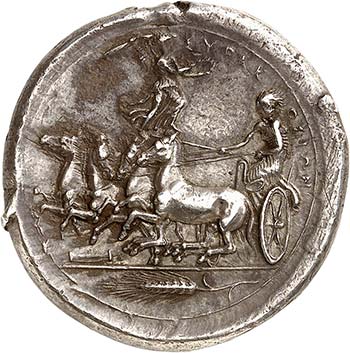- Home
- Asta 11 - A Royal Collection
- 1 Sicily. The most important Greek silver coin ever sold. ...
Lotto 1 - Asta 11 - A Royal Collection
Offerte
Descrizione
Syracuse. Silver Tetradrachm signed by Kimon, circa 405-400 BC. APEƟOΣA Head of Arethusa facing, slightly inclined to the left, wearing two necklaces; her hair flows on soft wawes around her head; on the ampyx over her forhead, the signature KIMΩN; on right two dolphins swimming and a third emerging from the hair to the left / ΣYPAK OΣIΩN Quadriga galloping to the left; the charioteer, holding reins and kentron, looks back at his pursuers; above Nike presenting a wreath to the charioteer; ear of barley in exergue. 16,90g. Rizzo pl. XLVIII, 10 (this obverse die); Gulbenkian 292 (these dies); Fischer-Bossert pl. 5, 9 (these dies); Kraay-Hirmer 122 (this obverse die) and 123 (this reverse die); Kunstwerke der Antike (this coin); Schefold WM 492 (this coin); Tudeer 79 (these dies).
Grading/Stato: Certainly the most beautiful greek coin in private hands. A masterpiece of sublime style. Extremely rare.
Though the facing-head portrait eventually became familiar at Amphipolis, Larissa, Rhodes and Tarsus in the 4th and 3rd Centuries B.C., it seldom was attempted in the West. The few facing-head dies from Sicily are acknowledged masterpieces, including this phenomenal work of Kimon, whose Arethusa Soteira, became a model for artists throughout the Mediterranean. The richness of this artist's work cannot be overstated, for the style and composition of this coin is essentially perfect. The details of the Arethusa's portrait are richly engraved, with their impact being intensified by the playful dolphins that dart through the floating strands of hair in the surrounding water. Katherine Erhart, in her dissertation on facing head Greek coins, offers praise: "...the master-engraver Kimon created a facing head of the fountain nymph, which is easily the most beautiful coin of all time, one applauded by ancient die-engravers and modern critics alike. ... No other engraver before or since has so magnificently exploited the compositional potential of the small circular coin flan." The combination of the obverse depicting 'Arethusa the Saviour,' a reverse dedicated to a victorious charioteer, and the innovative and remarkable quality of the dies, earmarks this as a commemorative issue. As such, it has been associated with the defeat of the Athenian fleet at Syracuse in 413 B.C. and with the good fate of the Syracusans in the otherwise devastating Carthaginian invasion of Sicily in 406/5 B.C. This issue broke with about a century of Syracusan tradition by using this portrait as the obverse rather than the reverse. This decision probably was rooted in practicality since the reverse die is more vulnerable as it absorbs the full energy of the hammer blow. Just a few years earlier one of the two facing-head reverse dies engraved by Eucleidas (Tudeer reverse die 37) developed a fatal crack beneath Athena's chin that widened with each successive strike. This must have guided Kimon's decision. However, after Kimon's ambitious facing-head the portrait on tetradrachms at Syracuse returned to being shown in profile on the reverse die. Indeed, it was not until Agathocles revived the tetradrachm at Syracuse toward the end of the 4th Century that the head became the obverse, in keeping with other Greek mints of the era. Kimon's work for this issue consists of two obverse and two reverse dies. Both obverses were used with both reverses, and none of the four dies was used with any other die – all further evidence that this was a stand-alone series made for a special occasion. Considering the effort expended by Kimon, it is worth commenting on the relative merits of his four dies, three of which he signed. Both obverse dies are masterful and unique creations, but if the more accomplished must be chosen it would be Tudeer's die 28, the one used to strike this coin. The portrait on that die is more mature and focused than the one of Tudeer 29, where Arethusa's gaze is engaging, yet tentative. Both have equally playful arrangements of the dolphins, but on this die they are cut deeply and boldly, whereas on die 29 they are softly engraved, almost as if they were an afterthought. Die 29, however, is of greater academic interest, for it bears the inscription ΣΩ (abbreviating ΣΩTEIPA, 'saviour' or 'deliverer') cleverly hidden in the curls of Arethusa's hair. Both reverse dies show a quadriga in high action, viewed at a slight angle. They represent momentary snapshots of a victorious team turning the bend as the charioteer attempts to contain the collective power of his team. The reverse dies are so different in their arrangements that it is impossible to make a choice on merit alone, and we might conclude that they are equally accomplished. The die used to strike this coin, Tudeers 54, is lively and powerful, yet it still possesses a sense of formality that is amplified by the unusual, upright posture of Nike, who advances toward the driver. The heads of the horses toss about in a precise arrangement that by this time had become canonical at Syracuse: the outermost horses maintain relatively controlled postures as the heads of the interior horses toss about wildly. The placement of a fallen meta (turning post) beneath the horses only adds to the drama of the scene. Text: courtesy of NAC.
Utilizzare il modulo di registrazione oppure effettuare il login cliccando sul link login in alto a destra.
Per qualsiasi informazione contattare auction@ngsa.ch
Asta 11 - A Royal Collection
Categorie
Asta: Asta 11 - A Royal Collection
Orari
Offerte pre-asta - Fine
17 11 2019 20:00 CET
Asta di sala - Inizio
18 11 2019 14:30 CET
Contatti
Rond-point de Plainpalais 1, Ginevra, Genève, Svizzera
 Il rispetto della tua riservatezza è la nostra priorità
Il rispetto della tua riservatezza è la nostra priorità
Questo sito fa uso di cookie per migliorare l’esperienza di navigazione degli utenti e per raccogliere informazioni sull’utilizzo del sito stesso. Puoi consultare la nostra cookie policy, accettare tutti i cookie e proseguire nella navigazione cliccando su "Accetta" oppure personalizzare la tua scelta cliccando su "Personalizza".
Cookie Policy
Cookies
Per far funzionare bene questo sito, a volte installiamo sul tuo dispositivo dei piccoli file di dati che si chiamano "cookies". Anche la maggior parte dei grandi siti fanno lo stesso.
Cosa sono i cookies?
Un cookie è un piccolo file di testo che i siti salvano sul tuo computer o dispositivo mobile mentre li visiti. Grazie ai cookies il sito ricorda le tue azioni e preferenze (per esempio login, lingua, dimensioni dei caratteri e altre impostazioni di visualizzazione) in modo che tu non debba reinserirle quando torni sul sito o navighi da una pagina all'altra.
Come utilizziamo i cookies?
Cookie di terze parti
Google Analytics
Questo sito utilizza Google Analytics per raccogliere informazioni circa l'utilizzo degli utenti del proprio sito web. Google Analytics genera informazioni statistiche e di altro genere attraverso i cookie, memorizzati sui computer degli utenti. Le informazioni generate relative al nostro sito web sono utilizzate per fare dei report sull’utilizzo dei siti web. Google memorizzerà ed utilizzerà queste informazioni. La politica sulla privacy di Google è disponibile al seguente indirizzo: https://policies.google.com/privacy.
Non è necessario abilitare i cookies perché il sito funzioni, ma farlo migliora la navigazione. È possibile cancellare o bloccare i cookies, però in questo caso alcune funzioni del sito potrebbero non funzionare correttamente.
Le informazioni riguardanti i cookies non sono utilizzate per identificare gli utenti e i dati di navigazione restano sempre sotto il nostro controllo. Questi cookies servono esclusivamente per i fini qui descritti.
Come controllare e modificare i cookies?
In qualsiasi momento è possibile modificare o revocare il proprio consenso dalla dichiarazione dei cookie sul nostro sito Web.
Informativa sulla privacy
Scopra di più su chi siamo, come può contattarci e come trattiamo i dati personali nella nostra informativa sulla privacy.
I cookie necessari contribuiscono a rendere fruibile il sito web abilitandone funzionalità di base quali la navigazione sulle pagine e l'accesso alle aree protette del sito. Il sito web non è in grado di funzionare correttamente senza questi cookie.
| Nome | Fornitore | Scopo | Scadenza |
|---|---|---|---|
| cookieConsent | Bid Inside | Memorizza lo stato del consenso ai cookie dell'utente per il dominio corrente | 6 mesi |
| PHPSESSID | Bid Inside | Preserva gli stati dell'utente nelle diverse pagine del sito. | Quando termina la sessione di navigazione |
| f_display | Bid Inside | I cookie f_display memorizzano la modalità di visualizzazione scelta dall'utente nelle pagine in cui sono presenti delle liste | Quando termina la sessione di navigazione |
| f_page | Bid Inside | I cookie f_page memorizzano la pagina visualizzata dall'utente nelle pagine in cui sono presenti delle liste | Quando termina la sessione di navigazione |
| f_rec_page | Bid Inside | I cookie f_rec_page memorizzano il numero di elementi da visualizzare per pagina scelto dall'utente nelle pagine in cui sono presenti delle liste | Quando termina la sessione di navigazione |
| f_order_by | Bid Inside | I cookie f_order_by memorizzano il parametro di ordinamento selezionato dall'utente nelle pagine in cui sono presenti delle liste | Quando termina la sessione di navigazione |
| f_order_dir | Bid Inside | I cookie f_order_dir memorizzano la direzione di ordinamento scelta dall'utente nelle pagine in cui sono presenti delle liste | Quando termina la sessione di navigazione |
| watch_list_show_imgs | Bid Inside | Il cookie watch_list_show_imgs memorizza la scelta dell'utente riguardo il mostrare o il nascondere le immagini dei lotti nella pagina con la lista dei lotti in osservazione | Quando termina la sessione di navigazione |
| selected_voice | Bid Inside | Il cookie selected_voice memorizza la voce selezionata dall'utente per la sintesi vocale presente nell'asta live | 1 Mese |
| include_autobids | Bid Inside | Il cookie include_autobids memorizza la scelta dell'utente di mostrare o nascondere le proprie auto-bid nella pagina 'Le tue offerte' | 6 mesi |
I cookie analitici aiutano a capire come i visitatori interagiscono con il sito web, raccogliendo e trasmettendo informazioni statistiche al Titolare del trattamento.
| Nome | Fornitore | Scopo | Scadenza |
|---|---|---|---|
| _ga | Registra un ID univoco utilizzato per generare dati statistici su come il visitatore utilizza il sito internet. | 2 anni | |
| _gat_gtag | Utilizzato da Google Analytics per limitare la frequenza delle richieste | 1 giorno | |
| _gat | Utilizzato da Google Analytics per limitare la frequenza delle richieste | 1 giorno | |
| _gid | Registra un ID univoco utilizzato per generare dati statistici su come il visitatore utilizza il sito internet. | 1 giorno | |
| __utma | Bid Inside | Utilizzato per distinguere utenti e sessioni. Il cookie viene creato quando viene eseguita la libreria javascript e non esistono cookie __utma esistenti. Il cookie viene aggiornato ogni volta che i dati vengono inviati a Google Analytics. | 2 anni |
| __utmt | Bid Inside | Utilizzato per limitare la velocità di richiesta. | 10 minuti |
| __utmb | Bid Inside | Utilizzato per determinare nuove sessioni/visite. Il cookie viene creato quando viene eseguita la libreria javascript e non esistono cookie __utmb esistenti. Il cookie viene aggiornato ogni volta che i dati vengono inviati a Google Analytics. | 30 minuti |
| __utmc | Bid Inside | Non utilizzato in ga.js. Impostato per l'interoperabilità con urchin.js. Storicamente, questo cookie operava insieme al cookie __utmb per determinare se l'utente si trovava in una nuova sessione/visita. | Quando termina la sessione di navigazione |
| __utmz | Bid Inside | Memorizza la sorgente di traffico o la campagna che spiega come l'utente ha raggiunto il tuo sito. Il cookie viene creato quando viene eseguita la libreria javascript e viene aggiornato ogni volta che i dati vengono inviati a Google Analytics. | 6 mesi |
| __utmv | Bid Inside | Utilizzato per memorizzare dati variabili personalizzati a livello di visitatore. Questo cookie viene creato quando uno sviluppatore utilizza il metodo _setCustomVar con una variabile personalizzata a livello di visitatore. Questo cookie è stato utilizzato anche per il metodo _setVar deprecato. Il cookie viene aggiornato ogni volta che i dati vengono inviati a Google Analytics. | 2 anni |
I cookie di preferenza/tecnici consentono a un sito web di ricordare le informazioni che influenzano il modo in cui il sito si comporta o si presenta, come la lingua preferita o la regione che ti trovi.
Non usiamo cookie di questo tipo.I cookie di profilazione vengono utilizzati per finalità di marketing, per monitorare i visitatori del sito web. L'intento è quello di visualizzare annunci pertinenti e coinvolgenti per il singolo utente.
Non usiamo cookie di questo tipo.I cookie non classificati sono i cookie che sono in fase di classificazione, insieme ai fornitori di cookie individuali.
Non usiamo cookie di questo tipo.




 2
2